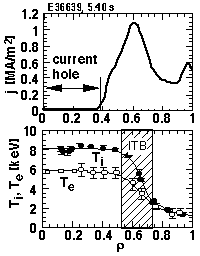Formation and Sustainment of tokamak equilibrium with a current hole in JT-60U
Takaaki Fujita and the JT-60 Team
Japan Atomic Energy Research Institute, Naka Fusion Research Establishment Naka-machi, Naka-gun, Ibaraki-ken 311-0193 Japan
Abstract.
In a toroidal system for confining a high temperature plasma, the poloidal magnetic field is necessary to suppress the drift of charged particles (ions and electrons) and to obtain good confinement. In a tokamak, which is one of the axisymmetric toroidal systems, the poloidal magnetic field is produced by a toroidal current in the plasma. A hollow current profile ("reversed shear configuration") has also been produced recently in the context of advanced tokamak concept, but a finite current at the center has been believed to be necessary for stable sustainment of the plasma.
Recently, it has been observed that a region with nearly zero toroidal current or a "current hole" is formed and sustained stably for several seconds in a central region of JT-60U reversed shear plasmas. An example is shown in Fig.1. In this case, the radius of current hole extended up to ~40% of plasma minor radius. The central current density was estimated less than 7% of current density averaged over the plasma cross section; q(0) was larger than 70. The current hole was established by decrease in a toroidal electric field through the increase of off-axis bootstrap current in the ITB layer. In the discharge of Fig. 1, the current hole with a radius of ρ > 0.25 was sustained for 4 to 5 seconds without any global MHD instabilities and with high confinement. This indicates the possibility of stable operation of tokamaks with no toroidal current at the axis and may lead to new concepts for tokamak reactors regarding current profiles and/or plasma current drivers.
One interesting point is that no substantial negative central current has been observed so far. This fact suggests that the decrease of central current stops when the central current density becomes zero. Furthermore, it seems that ECCD or NBCD do not generate the current in the current hole. These observations of the stiffness of current hole suggest that the current hole is not a result of transient zero toroidal electric field in the plasma core, but of some kind of self-organized structure.

Fig.1. Radial profiles of current density (j), Ti and Te in an equilibrium with a current hole.
